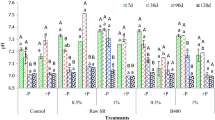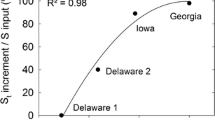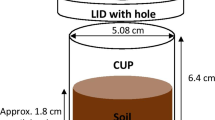Summary
Topsoils (0–75 mm) from four soil types with different sulphate retention capacities were collected from stock camp and non-camp (main grazing area) sites of grazed pastures in New Zealand which had been annually fertilized with superphosphate for more than 15 years. These soils were analysed for different S fractions and incubated at 30°C for 10 weeks using an open incubation technique in order to assess the extent of S mineralization and the release of soluble soil organic S from camp and non-camp soils during incubation. The soils were preleached with 0.01 M KCl, followed by 0.04 M Ca(H2PO4)2 before being incubated. Pre-incubation leachates and weekly 0.01 M KCl leachates were analysed for mineralized S (i.e., hydriodic acid-reducible S) and total S. Soluble organic S was estimated as the difference between these two S fractions. Results obtained show higher cumulative amounts of all three S fractions in leachates over a 10-week incubation period in camp than in non-camp soils, suggesting that higher mineralization occurred in camp soils. Cumulative amounts of mineralized S from camp and non-camp soils showed a linear relationship with duration of incubation (R 2≥0.985***), while the cumulative release of soluble organic S followed a quadratic relationship (R 2≥0.975***). A significant proportion (14.6%–40.8%) of total S release in KCl leachates was soluble organic S, indcating that organic S should be taken into account when assessing S mineralization. Mineralized S and soluble organic S were best correlated with 0.01 M CaCl2-extractable soil inorganic S (R 2=0.767***) and 0.04 M Ca(H2PO4)2-extractable soil inorganic S(R 2=0.823***), respectively. Soil sulphate retention capacity was found to influence amounts of mineralized S and soluble organic S, and thus periodic leaching with KCl to remove mineralized S from soils may not adequately reflect the extent of soil S mineralization in high sulphate-retentive soils. In low (<10%) sulphateretentive soils, increasing the superphosphate applications from 188 to 376 kg ha−1 year−1 increased S mineralization but not amounts of C-bonded and hydriodic acid-reducible soil S fractions.
Similar content being viewed by others
References
Acquaye DK, Kang BT (1987) Sulphur status and forms in some surface soils of Ghana. Soil Sci 144:43–52
Barrow NJ (1987) Return of nutrients by animals. In: Snaydon RW (ed) Ecosystems of the world 17B. Managed grasslads analytical studies. Elsevier, Amsterdam, pp 181–186
Beauchamp EG, Reynolds WD, Brasche-Villeuve D, Kirby K (1986) Nitrogen mineralization kinetics with different soil pretreatments and cropping histories. Soil Sci Soc Am J 50:1478–1483
Biederbeck VO (1978) Soil organic sulfur and fertility. In: Schnitzer M, Khan SU (eds) Soil organic matter. Elsevier, Amsterdam, pp 273–310
Ellert BH, Bettany JR (1988) Comparison of kinetic models for describing net sulfur and nitrogen mineralisation. Soil Sci Soc Am J 52:1692–1702
Freney JR, Melville GE, Williams CH (1969) Extraction, chemical nature and properties of soil organic sulphur. J Sci Food Agric 20:440–445
Ghani A, McLaren RG, Swift RS (1991) Sulphur mineralisation in some New Zealand soils. Biol Fertil Soils 11:68–74
Johnson CM, Nishita H, (1952) Micro-estimation of sulphur in plant materials, soils and irrigation waters. Anal Chem 24:736–742
Kilmer VJ, Nearpass DC (1960) The determination of available sulfur in soils. Soil Sci Soc Am Proc 24:337–340
Lewis DC, Clarke AL, Hall WB (1987) Accumulation of plant nutrients and changes in soil properties of sandy soils under fertillised pasture in South-Eastern South Australia: II. Total sulphur and nitrogen, organic carbon and pH. Aust J Soil Res 25:203–210
McGill WB, Cole CV (1981) Comparative aspects of cycling of organic C, N, S and P through soil organic matter. Geoderma 26:267–286
Ndayegamiye A, Côté D (1989) Effect of long-term pig slurry and solid cattle manure application on soil chemical and biological properties. Can J Soil Sci 69:39–47
Nguyen ML, Goh KM (1990) Accumulation of soil sulphur fractions in grazed pastures receiving long-term superphosphate applications. NZ J Agric Res 33:111–128
Nguyen ML, Goh KM (1992a) Nutrient cycling and losses based on a mass-balance model in grazed pastures receiving long-term superphosphate applications in New Zealand, 2. Sulphur J Agric Sci 119:107–122
Nguyen ML, Goh KM (1992b) Status and distribution of soil sulphur fractions, total nitrogen, and organic carbon in camp and non-camp soils of grazed pastures receiving long-term superphosphate applications. Biol Fertil Soils 14:181–190
Nguyen ML, Rickard DS, McBride SD (1989) Pasture production and changes in phosphorus and sulphur status in irrigated pastures receiving long-term applications of superphosphate fertilizer. NZ J Agric Res 32:245–262
Persson T (1989) Role of soil animals in C and N mineralisation. Plant and Soil 115:241–245
Pirela HJ, Tabatabai MA (1988) Sulphur mineralisation rates and potentials of soils. Biol Fertil Soils 6:26–32
Rehm GW, Caldwell AC (1968) Sulfur supplying capacity of soils and the relationship to soil type. Soil Sci 105:355–361
Saggar S, MacKay AD, Hedley MJ, Lambert MG, Clark DA (1990) A nutrient transfer model to explain the fate of phosphorus and sulphur in a grazed hill-country pasture. Agric Ecosyst Environ 30:295–315
SAS (1987) Stastistical analysis system. SAS/STAT Guide for personal computers, version 6. SAS Institute Inc, Cary, North Carolina
Schoenau JJ, Bettany JR (1987) Organic matter leaching as a component of carbon, nitrogen, phosphorus and sulphur cycles in a forest, grassland and gleyed soil. Soil Sci Soc Am J 51:646–651
Smith SJ (1987) Soluble organic nitrogen losses associated with recovery of mineralized nitrogen. Soil Sci Soc Am J 51:1191–1194
Smith JL, Schnabel RR, McNeal BL, Campbell GS (1980) Potential errors in the first order model for estimating soil nitrogen mineralization potentials. Soil Sci Soc Am J 44:996–1000
Snaydon RW (1987) Ecosystems of the world 17B: Managed grasslands analytical studies. Elsevier, Amsterdam
Sorn-Sirivichai P (1980) Mineralisation of soil organic sulphur in the Tokomaru silt loam. M Agr Sci Thesis, Massey University, New Zealand
Steinbergs A, Isimaa O, Freney JR, Barrow NJ (1962) Determination of total sulphur in soil and plant materials. Anal Chim Acta 27:158–164
Tabatabai MA, Al-Khafaji AA (1980) Comparison of nitrogen and sulphur mineralisation in soils. Soil Sci Soc Am J 44:1000–1006
Till AR, Saunders WMH, Sinclair AG (1987) Plant nutrient sulphur requirements: Oceania. In: Sulphur 87. World Regional Requirements, Plant nutrient sulphur. The Sulphur Institute and the British Sulphur Corporation, Houston, Texas, pp 63–73
Author information
Authors and Affiliations
Rights and permissions
About this article
Cite this article
Nguyen, M.L., Goh, K.M. Sulphur mineralization and release of soluble organic sulphur from camp and non-camp soils of grazed pastures receiving long-term superphosphate applications. Biol Fert Soils 14, 272–279 (1992). https://doi.org/10.1007/BF00395463
Received:
Issue Date:
DOI: https://doi.org/10.1007/BF00395463




